Craving a dish that is light yet comforting? This easy, homemade Ochazuke with green tea or dashi, steamed rice, and simple savory toppings will hit the spot.
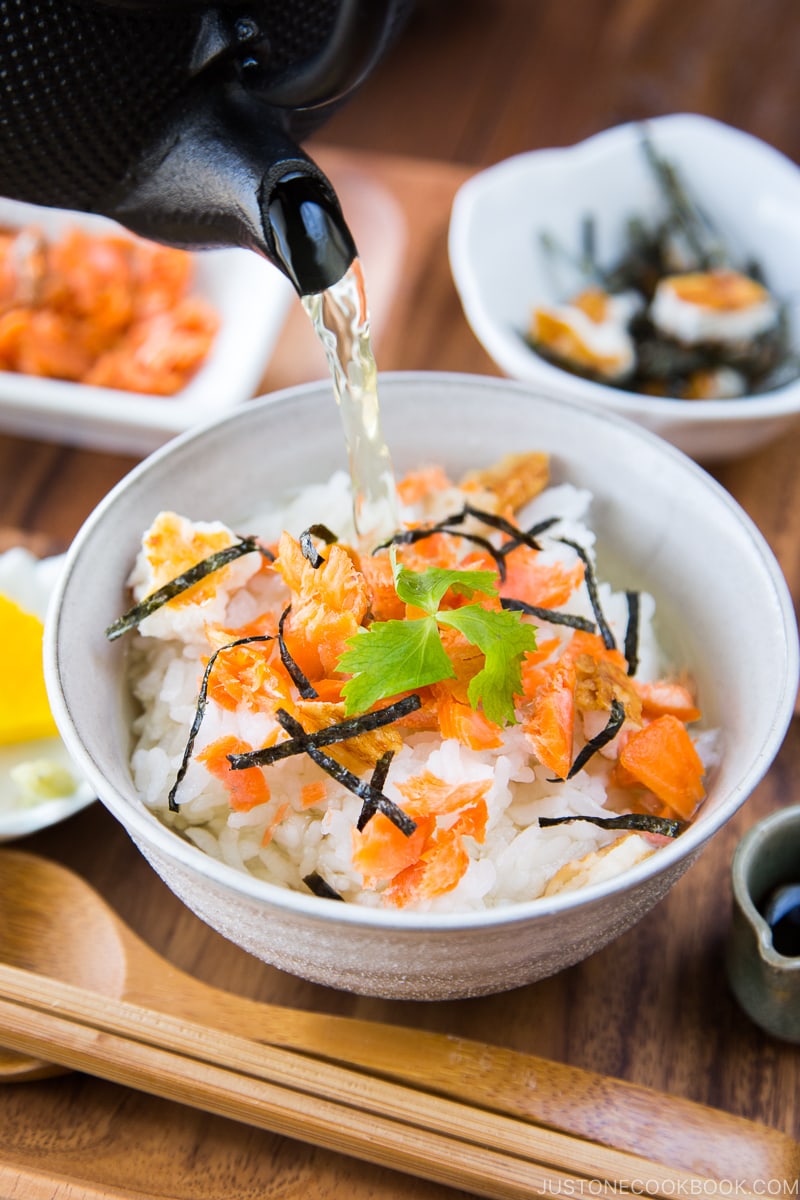
Ochazuke (お茶漬け) is a simple one-bowl dish featuring steamed rice with an assortment of savory ingredients, partially steeped in green tea. Ocha refers to green tea, and zuke means “submerged”. Instead of proper mealtime food, the Japanese enjoy it more as a quick meal or at the end of the meal to fill up.
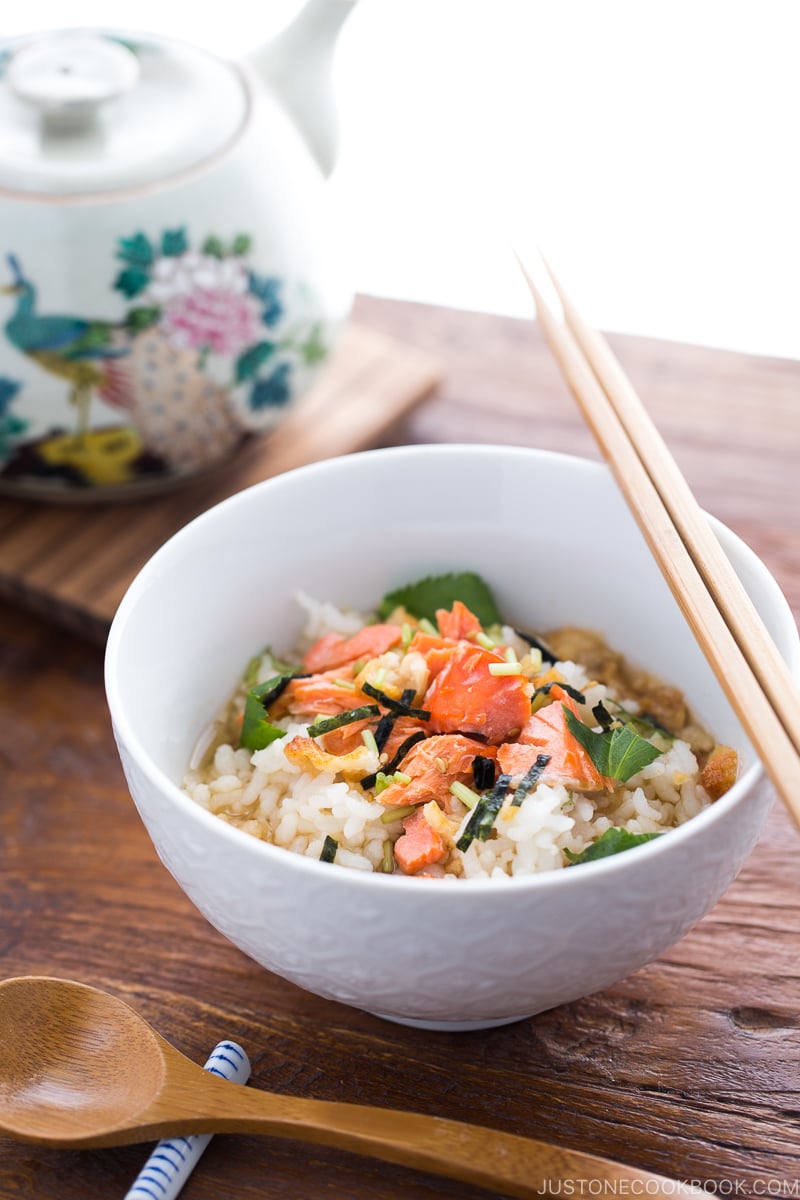
Ochazuke – The Comfort Food
Soothing to eat and easy on the stomach, Ochazuke is the kind of comfort food that I crave. When I suffer from jet lag after a long plane ride from Japan, I would always make the rice dish to satisfy my midnight hunger pangs. The warm tea and rice were well received by my exhausted body and tasting it immediately comforted my homesickness.
We often eat Ochazuke when we feel under the weather or simply when there are no other ingredients to cook with. It’s the easiest meal to put together! All the ingredients are the usual staples from a Japanese pantry.
In Japanese manga and drama, you’ll find scenes of Japanese student scarfing down a bowl of Ochazuke while burning the midnight oil, or a tired salaryman gets home from work and need something quick to eat before hitting the snooze button.
Ochazuke is a perfect quick meal to ease your hunger, as it’s light and can be quickly prepared. It also has the magic to make you feel all warm and fuzzy inside after eating.
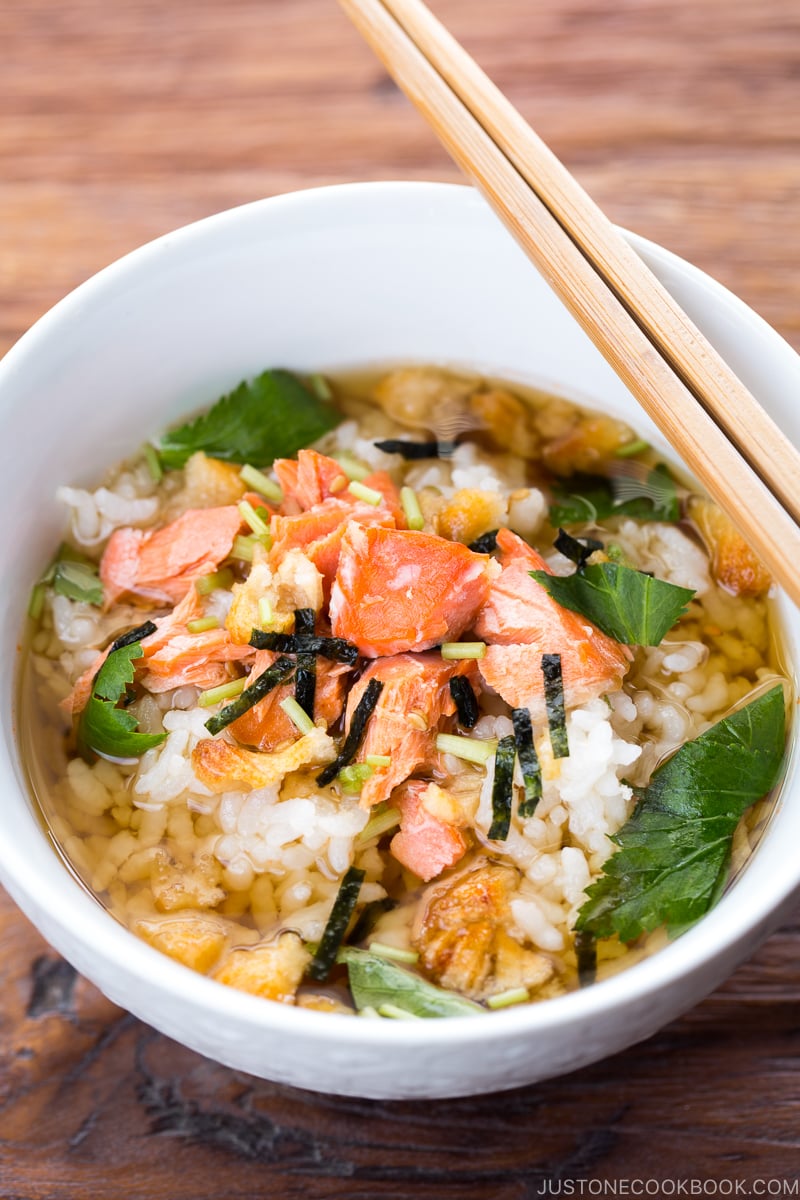
Types of Green Tea & Broth You Can Use for Ochazuke
You can use various kinds of green tea such as Genmaicha, Sencha, Hojicha, etc to make Ochazuke. However, when you order Ochazuke in Japanese restaurants, it is typically made with dashi broth instead of green tea.
The Ochazuke served with green tea tends to be bland and relies on salty toppings to add more flavor. But with good dashi, the dish can be very flavorful even with just a few simple toppings.
You can also make it with cold tea or broth in the summertime.

Suggestions for Toppings
I know some of the ingredients are quite hard to get outside of Japan, so feel free to change it up. You can keep it simple by using leftover rice and whatever you have from the fridge!
Here are the ingredients commonly used to make Ochazuke:
- Bubu Arare (tiny rice cracker balls; Amazon sells it)
- Japanese pickles like umeboshi (salted pickled plum)
- Nori seaweed
- Pollock roe (tarako & mentaiko)
- Salmon Flakes (recipe coming soon!)
- Salmon roe (ikura)
- Salted Salmon
- Scallion or mitsuba
- Sea Bream (tai) sashimi
- Sesame seeds
- Wasabi
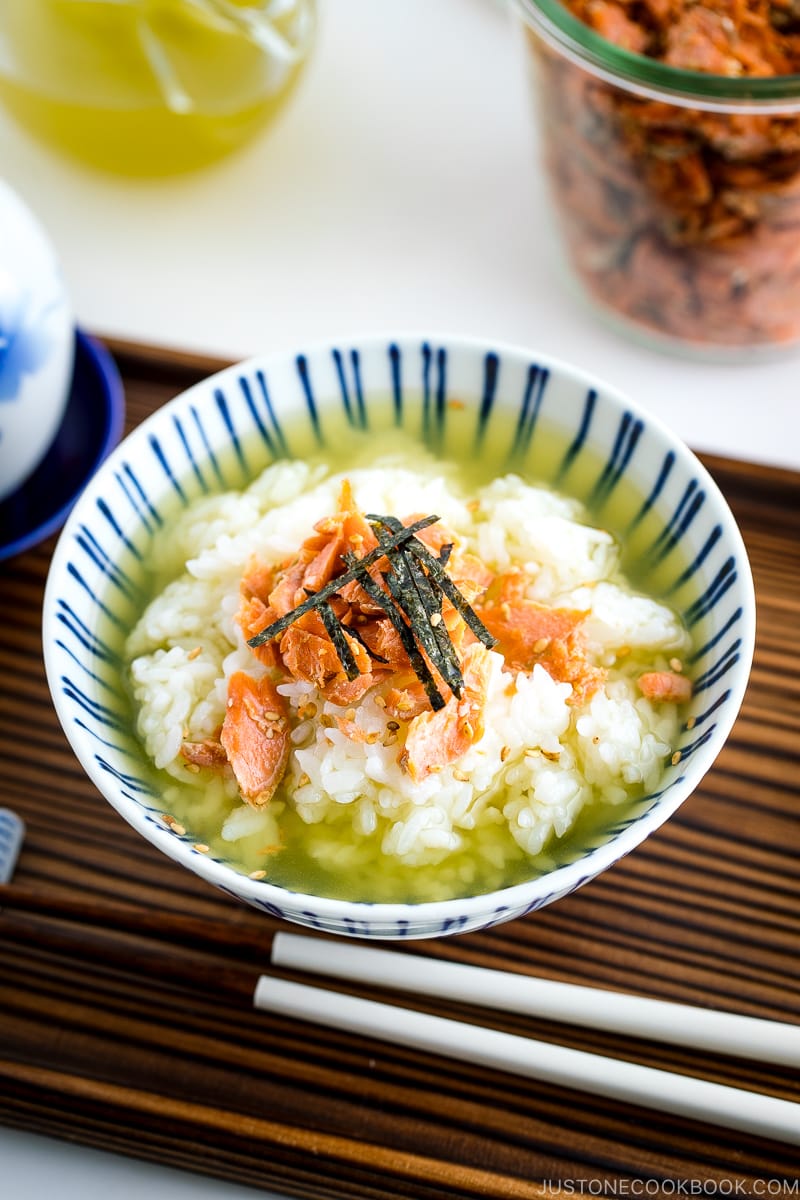
There are instant ochazuke packets you can buy from Japanese/Asian grocery stores or Amazon. They include dried pickled plum, salmon, nori, rice crackers, and green tea, and all you need to do is pour hot water or tea over. It’s convenient, but you can’t beat the taste and flavor of homemade Ochazuke.
I often make the recipe when I have leftover salted salmon. It is especially comforting and delicious with homemade dashi broth! I wouldn’t even mind eating it for breakfast, lunch or dinner.
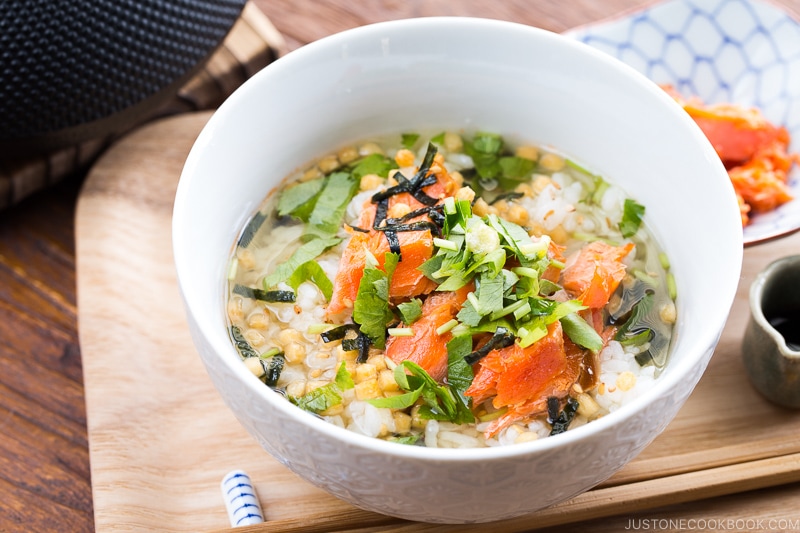
Wish to learn more about Japanese cooking? Sign up for our free newsletter to receive cooking tips & recipe updates! And stay in touch with me on Facebook, Pinterest, YouTube, and Instagram.

Ochazuke (Green Tea Over Rice)
Ingredients
- 1 fillet Homemade Japanese Salted Salmon (or ½ fillet regular salmon and a pinch of salt; you can also use any leftover cooked salmon)
- 1 cup cooked Japanese short-grain rice
- 1 tsp bubu arare (crispy puffed rice pellets) (or crushed Japanese rice crackers)
- 1 tsp shredded nori seaweed (kizami nori)
- ¼ tsp toasted white sesame seeds
- 2 sprigs mitsuba (Japanese parsley) (or ⅛ scallion, cut into small pieces)
- wasabi (optional, to taste)
For Ochazuke with Dashi
- 1 cup dashi (Japanese soup stock) (use standard Awase Dashi, dashi packet or powder, or Vegan Dashi)
- 1 tsp mirin
- 1 tsp soy sauce
- ⅛ tsp Diamond Crystal kosher salt
For Ochazuke with Green Tea
- 2 tsp Japanese green tea leaves (I used genmaicha, but sencha, hojicha, and mugicha also work; use 3 g (1 tsp) tea leaves per 100 ml (about ½ cup) hot water)
- 1 cup hot water (see the tea leaves package for the appropriate water temperature to use)
- ½ tsp soy sauce (optional)
Instructions
- Gather all the ingredients. The ingredients are pictured for Ochazuke with Dashi on the left and Ochazuke with Green Tea on the right.

To Prepare the Ingredients
- Preheat the oven to 425ºF (218ºC). For a convection oven, reduce the cooking temperature by 25ºF (15ºC). Bake 1 fillet Homemade Japanese Salted Salmon for 20–25 minutes until the skin and flesh are blistered and charred (Japanese salted salmon is always cooked until firm and well done). Once cool enough to handle, remove the skin and bones and break up the salmon flesh into flakes. Set aside. Tip: If you’re using regular salmon, season it with a pinch of salt and set it aside for 10 minutes before baking. You can also substitute any leftover teriyaki, grilled, or pan-fried salmon for a slightly different flavor.

- If you don’t have 1 tsp bubu arare (crispy puffed rice pellets), crush Japanese rice crackers into small pieces (you can also use a bag to crush it).

To Prepare the Dashi or Tea
- Ochazuke with Dashi: Combine 1 cup dashi (Japanese soup stock), 1 tsp mirin, 1 tsp soy sauce, and ⅛ tsp Diamond Crystal kosher salt in a small saucepan and bring it to a boil. Pour the soup into a small teapot and keep warm.

- Ochazuke with Tea: Put 2 tsp Japanese green tea leaves in a pot or teapot. Bring 1 cup hot water to the appropriate temperature for your tea and pour it into the pot. Set aside for 1–2 minutes (follow the directions on your tea package).

To Serve
- For each serving, portion 1 cup cooked Japanese short-grain rice in an individual bowl. Add the flaked salmon on the rice and sprinkle 1 tsp bubu arare or crushed rice crackers, 1 tsp shredded nori seaweed, and ¼ tsp toasted white sesame seeds on top. Serve tsukemono (pickles), such as Pickled Cucumber, on the side as a part of the meal.

- Ochazuke with Dashi: When you‘re ready to eat, pour the hot dashi into the bowl to cover the rice halfway and top with 2 sprigs mitsuba and wasabi. Enjoy!

- Ochazuke with Tea: When you‘re ready to eat, pour the hot tea into the bowl to cover the rice halfway and top with 2 sprigs mitsuba and wasabi. Add ½ tsp soy sauce, if you‘d like. Enjoy!

For Ochazuke in the Summertime
- You can use cold rice and cold dashi or tea (I love mugicha or barley tea) in the summertime to enjoy a cool and refreshing version of Ochazuke.
Nutrition
Editor’s Note: The post was originally published on July 23, 2014. It’s been edited and republished in April 2020.


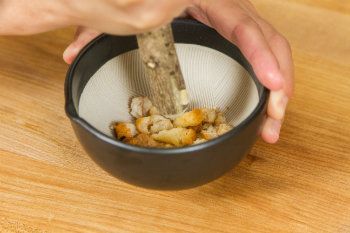
















My favorite to eat whenever I felt under the weather or sick. So much comfort in this yummy bowl of goodness.
Hi Corliss! Thank you so much for trying Nami’s recipe!
We’re pleased to hear this dish brings you comfort. Happy Cooking!
I made this with shiozake, green tea, some fun mix-ins for the rice (shiso, salted cucumbers, etc.), nori, and some really cute little sakura arare I found. Thank you so much for the recipe/inspiration, it was delicious and brought back tons of memories of my time in Japan!
Hi Ahmad! Thank you very much for sharing your cooking experience and for your kind feedback!
We are so happy to hear that the food brought back good memories of your time in Japan! Happy Cooking! 💞
Yum! This has always been my comfort food! We went through bowls of ochazuke at Bachan’s house. First time I’ve heard of it with dashi! Look forward to telling my mom!
She keeps being surprised at what she missed out on. Your recipes really help us expand our heritage. We really appreciate all the work you do!
Hi Liv, We couldn’t be happier to hear how much joy and excitement Nami’s recipe has brought to you and your family!
Thank you very much for reading Nami’s post and sharing the story with us. Happy Cooking! 🙂
Made it with Jasmine Tea and Furikake. So delicious, thank you for so many great traditional recipes. I saw this on Midnight Diner and had to try it!
Hi John! We are glad to hear you enjoyed Ochazuke!
Thank you very much for your feedback!😊
Hello Nami from snowy Moscow 🙂 Now ochazuke is my fav.express comforting soup after long walkings 🙂 Today I used flakes of fried halibut and katsuo furikake and a drop of wasabi for heat! It’s so delicious!
Hi Olga! We are so happy to hear now Ochazuke is your comforting food!
Thank you very much for trying Nami’s recipe and sharing your cooking experience with us!🥰
You only need green tea and steamed rice that has cooled to make Ochazuke. Anything else you add to it, is your own choice, but it is not a requirement. Trust me, I grew up eating this. Its just green tea poured over steamed rice.
Hi Fred! Thank you very much for reading Nami’s post and for your input!
Yes! The simpler is the best.😊
Can i substitute other fish for salmon?
Hi Johanna, Sure! You can use another type of fish. White meat fish is also good too.
Thank you very much for trying Nami’s recipe!
Dear Nami,
I just finished reading your post about onigiri, and you mentioned ochazuke onigiri. I’ve come to the ochazuke recipe but I can’t find the ochazuke onigiri instructions… maybe I’ve missed them? Please help, I love ochazuke so much! Thank you so much and take care. Greetings from London.
Hi Rea! Thank you very much for reading Nami’s post from London!
We are so happy to hear you love Ochazuke! We are not sure where you see Ochazuke Onigiri.🤔 We normally don’t mix Ochazuke and Onigiri…
I have to admit I was doubtful but I was wrong – it is a lovely soothing dish. I tried both but especially liked the dashi broth version. I had some leftover salmon (made according to you black cod recipe which I have made so many times now) it worked lovely!
Hi Afra, Aww… Thank you very much for trying many of Nami’s recipes and for your kind feedback!
We are so happy to hear you had tried both versions of this Ochazuke.😃 Happy Cooking!
this was delicious and so easy to make for a cooking novice like me. i live near a japanese market so it was easy to find good quality tea and some mitsuba and pre-made salted salmon. i saw your post on how to make salmon flakes at home and i can’t wait to try next time from scratch. thanks so much for sharing this yummy recipe!
Hi Viviana, We are so glad to hear you enjoyed this homemade Ochazuke! We have many easy Japanese recipes on-site. Please enjoy! https://www.justonecookbook.com/tags/easy/
I normally use a mix of ほじちゃand matcha. And add a tad of soy sauce over the top. Makes for an amazing base for おちゃずぇ。
Hi 光太, Thank you for sharing your cooking experience with us!🙂
Wow! This is amazing! It tastes just like the delicious homemade ochazuke I had at a restaurant in Japan. I grew up in the states eating instant ochazuke but this is SO much better. Thank you!
Hi Erri, Thank you very much for trying this recipe and for your kind feedback! We are so happy to hear you enjoyed homemade Ochazuke!
Always good to have more simple stuff to do with dashi. I was concerned going in because I have sadly run out of kombu (I suspect imports have been hampered as my local asian grocery has not resupplied in some time; I will try ranging further afield, or just ordering some online) so it was made with straight shiitake dashi. I also used black rice for it mostly out of a sense of curiosity, and some rice seasoning we had sitting around that needed to be used up.
Worked out fine; the dashi broth actually complements black rice fairly well, although I suspect it would NOT work with green tea (no matter; I can’t actually have green tea anyway due to immune suppression), and the mushrooms do double duty as a topping after making the dashi to produce a simple, but satisfying result. Seems very easy on the stomach, as suggested, so a good option to have. I look forward to trying it with awase dashi and some different toppings when opportunity arises.
Hi DC,
Thank you very much for trying this recipe!
We are sorry to hear that your local Asian grocery store is not resupplying Kombu.😞 But we are glad to hear you find a way to enjoy this recipe. 🙂
Thank you for sharing your cooking experience with us.
A quick update: Today, I gave this a shot (dashi ver.) with the all-purpose miso meat sauce (https://www.justonecookbook.com/miso-meat-sauce-niku-miso/) as a topping, and found that the liquid components of the sauce mix with the dashi broth to produce something with a richer flavor that’s still pretty easy on the stomach. I used enough broth that the final result almost ended up looking like a soup, which may have contributed, but I am NOT complaining. All-purpose, indeed! Perhaps not as quick and easy, although I know what I’m going to do with meat sauce leftovers in the future.
Clearly I underrated this highly versatile recipe originally.
Hi DC,
What a great idea! Thank you very much for sharing your cooking experience with us.🙂